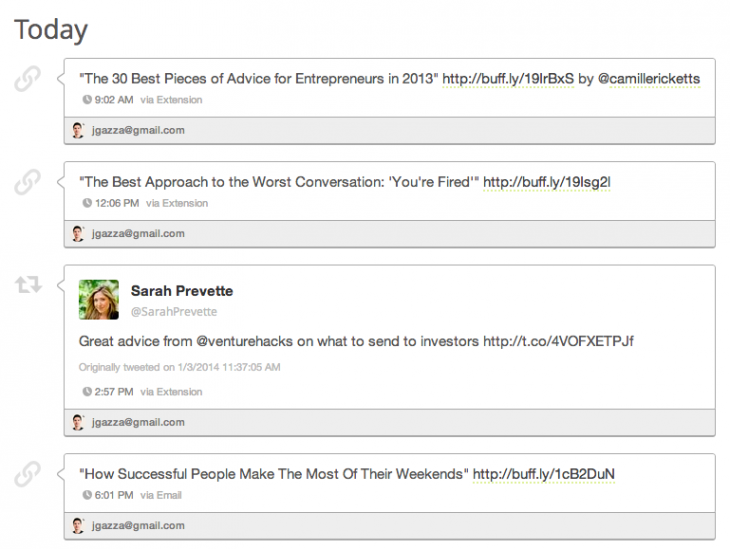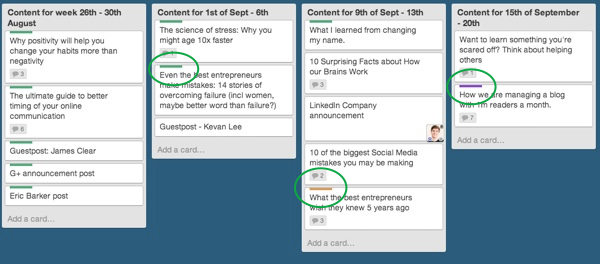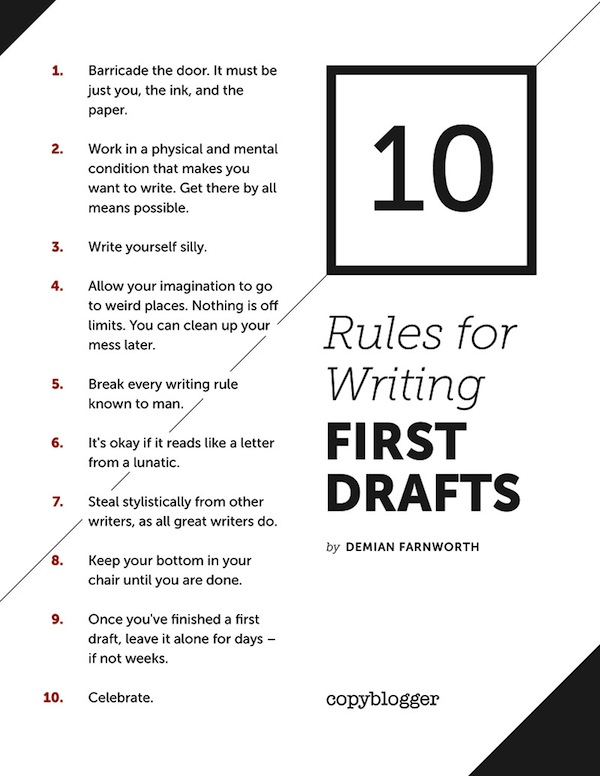
This post originally appeared on the Buffer blog.
When you’re facing a blank page with no idea what to write, it’s hard to imagine how you’ll ever get to the other side of a finished piece. I’ve gone through this a few times, so I thought it might be helpful to share the methods that have worked for me.
1. Be honest & work your struggles into your content
This is actually the method that inspired this post. I was working on a post about Google Analytics recently and I was struggling to get started.
After a few false starts, I finally decided to just write my concerns into the post. It turned out well, and made me think that sharing this method, and others I use, could be helpful to others.
Here’s how the intro to my Google Analytics post ended up:
Admission time: I don’t know much about Google Analytics. In fact, I generally gloss over when I read anything about it, since I usually find it all quite overwhelming and hard to understand. And not that much fun, to be honest.
But, being a content marketer, I can’t afford to ignore Google Analytics. It’s a great (free!) tool that helps us keep track of our goals for the Buffer blog and understand where we can improve.
If you’re in a similar situation to me, hopefully this post will highlight some of the most useful parts of Google Analytics for content marketing, and how you can use that data to your advantage. Without being boring! At least, I’ll give it my best shot…
2. Use your own experience
One method I’ve used a lot at Buffer is to use our internal experiences as a basis for blog posts. When we run an experiment or change up our internal routines, this can be really useful to explore on the blog.
Let’s look at some examples of how I’ve used this method:
How the Founder of Buffer Tweets: The System and 5 types of Tweets to Keep your Followers Engaged

This was a recent post I did after chatting to our CEO, Joel, about his tweeting habits. I talked to Joel about the 5 types of Tweets and how he uses them in his personal Twitter strategy. I was able to write a helpful social media post with solid advice by using what I learned in my conversation with Joel.
How Twitter’s new expanded images increase clicks, retweets and favorites [New data]

This was a fun post to write, because I did some analysis of the analytics we had for our @buffer Twitter account. From the data, I got some help from our team to create graphs to show the improvements we’d seen in engagement on Twitter due to Twitter’s new inline image preview feature.
8 Helpful Online Tools To Keep Your Company On Track

For a different style, this post was a roundup of tools we use internally at Buffer. I took screenshots of each tool and explained how they help us to be more productive and in-sync with each other.
3. Just write—even if it’s terrible
In a post I wrote for Buffer on the best advice from successful writers, I explored the “blank page” hurdle, and how to get over it. Here’s what I wrote at the time:
I write because it comes out — and then to get paid for it afterwards? I told somebody, at some time, that writing is like going to bed with a beautiful woman and afterwards she gets up, goes to her purse and gives me a handful of money. I’ll take it. — Charles Bukowski
Unlike Charles Bukowski, writing well doesn’t come so easily for a lot of us (including me). It takes a lot of mental energy, strains your working memory and often makes you feel vulnerable if you try to be open and honest in your work.
The pure effort of writing is hard enough, but coupled with the pain of putting your work out into the world and letting others judge it, this can be enough to stop you from getting started at all.
The trick to overcoming this isn’t easy, but it’s surprisingly effective: give yourself permission to write badly, and just start.
Anne Lamott, author of Bird by Bird wrote an excellent essay on why writers must start with horrible drafts:
I know some very great writers, writers you love who write beautifully and have made a great deal of money, and not one of them sits down routinely feeling wildly enthusiastic and confident. Not one of them writes elegant first drafts. All right, one of them does, but we do not like her very much.
Anne’s essay makes me feel much better about the hard work of writing great content, as she makes it clear that all great writers struggle with their first drafts:
We all often feel like we are pulling teeth, even those writers whose prose ends up being the most natural and fluid.
So to get over the biggest hurdle—the blank page—just get writing. Don’t be afraid that your draft might be bad (it probably will be, but that’s okay.)
Almost all good writing begins with terrible first efforts. You need to start somewhere. Start by getting something – anything – down on paper.
I love this image from Copyblogger on writing first drafts, too:

4. Draw from what you’re reading
Something I’ve been doing more of lately is pulling from small sections of the books I’m reading and expanding on a specific point they make to develop a blog post. Often a book will cover a lot of ground in one area, but a blog post is short enough to focus on one interesting point.
I just wrote a post using this technique:
Why positive encouragement works better than criticism, according to science
I lean heavily on two books by Daniel Goleman in this post. After I saw an article written by Goleman about the effects of positive and negative feedback, I started reading about this topic further in each of his books.
While his books cover far more than positive encouragement, I was able to draw on this specifically, taking only the most relevant points for my post.
5. Draw on what others have said about the topic as a starting point
Looking at what others have said about a topic is a really helpful method for me when I’m struggling to get started. I’m lucky that we’ve had some great writers contribute to the Buffer blog, so often I can start here.
Here are a couple of examples of where I’ve used this method:
8 Things You Don’t Know Are Affecting Our Choices Every Day: The Science of Decision Making
In this post, I referenced an earlier Buffer post by Brian Bailey and drew on what he’d already written about the process of decision-making. This gave me a start to get past the blank page, and helped me to develop the structure of my post.
How naps affect your brain and why you should have one every day
I used one of Leo’s earlier Buffer posts for this one. Since I was writing about the benefits of naps, it made sense to start with sleep in general and how that affects us. Using Leo’s earlier post as a starting point, I worked from writing about sleep to more specific points about naps.
I’ll bet you’ve got some other methods that work well for you when you’re struggling to get a post started. Let us know what works best for you in the comments.
Get the TNW newsletter
Get the most important tech news in your inbox each week.




